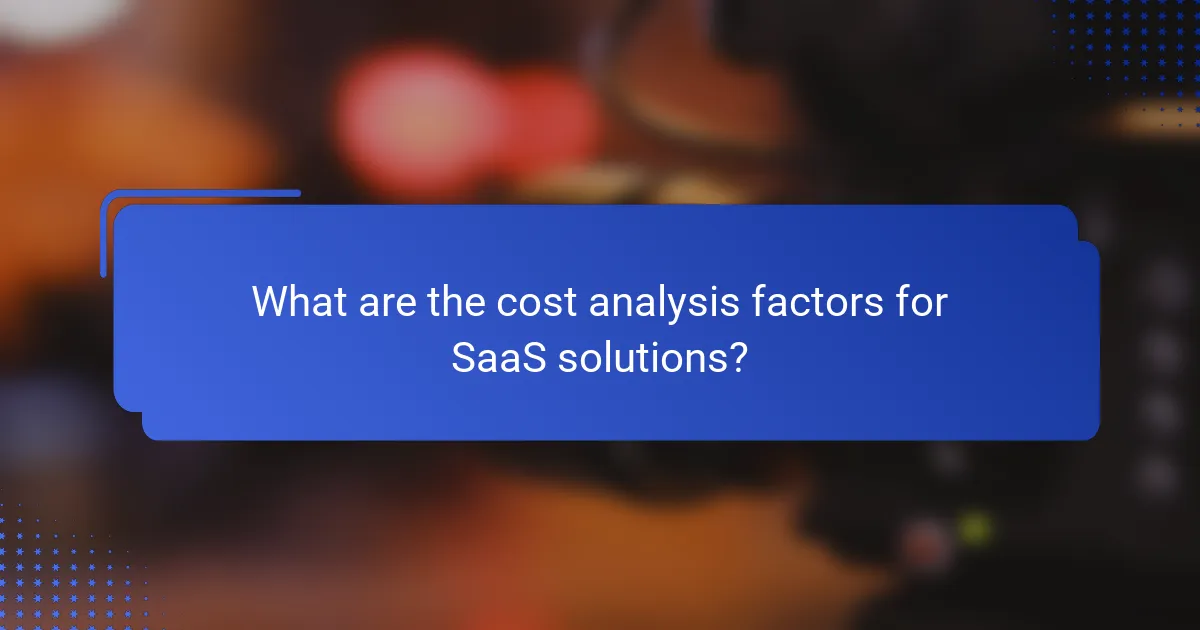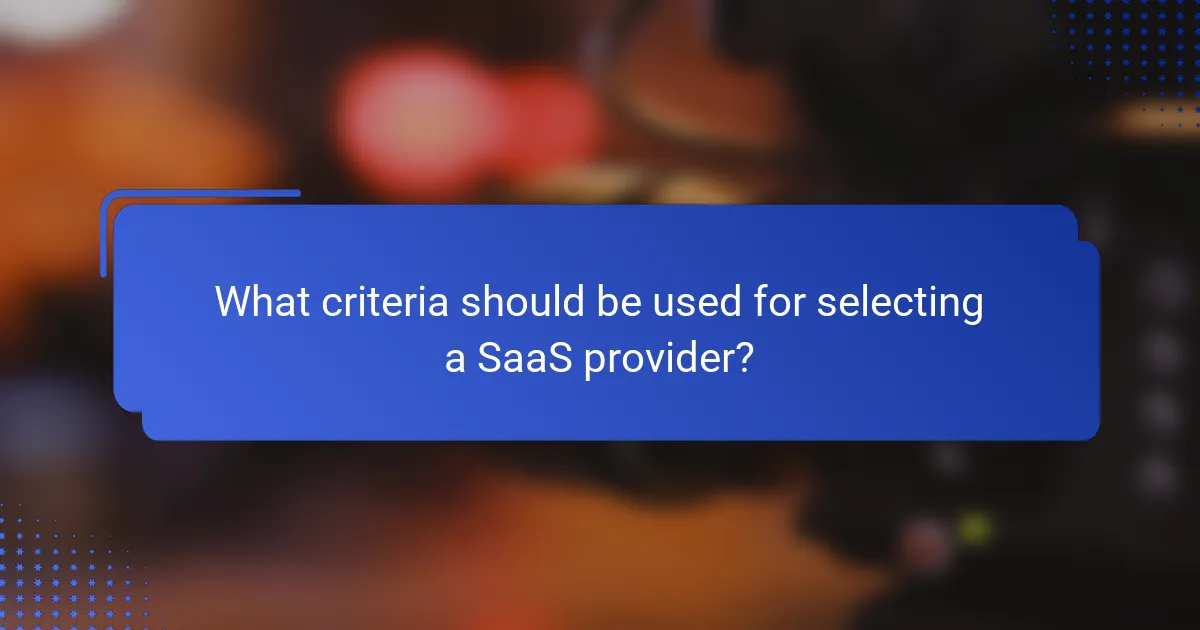As businesses increasingly turn to Software as a Service (SaaS) solutions, understanding scalability options, performance metrics, and cost analysis becomes essential for making informed decisions. From horizontal and vertical scaling to multi-cloud strategies, each scalability option presents unique benefits tailored to different growth needs. Additionally, performance comparison across providers highlights critical factors such as speed and reliability, while a thorough cost analysis ensures that businesses can evaluate pricing structures and hidden costs effectively.

What are the best SaaS scalability options in Canada?
The best SaaS scalability options in Canada include horizontal scaling, vertical scaling, multi-cloud strategies, auto-scaling features, and load balancing techniques. Each option offers unique advantages and considerations that can help businesses effectively manage growth and resource allocation.
Horizontal scaling
Horizontal scaling involves adding more machines or instances to handle increased load. This approach is particularly beneficial for applications that can distribute workloads across multiple servers, allowing for better performance and redundancy.
When implementing horizontal scaling, consider using container orchestration tools like Kubernetes, which can automate the deployment and management of containerized applications. This can lead to significant cost savings and improved resource utilization.
Vertical scaling
Vertical scaling, or scaling up, means upgrading existing hardware or resources on a single server to improve performance. This can include increasing CPU, RAM, or storage capabilities.
While vertical scaling can be simpler to implement, it has limitations, such as a maximum capacity for hardware upgrades. Businesses should evaluate their needs and consider the potential downtime during upgrades.
Multi-cloud strategies
Multi-cloud strategies involve using services from multiple cloud providers to enhance flexibility and reduce dependency on a single vendor. This approach can improve redundancy and enable businesses to leverage the best features from different platforms.
When adopting a multi-cloud strategy, ensure that data transfer between clouds is efficient and secure. Consider compliance with Canadian data residency regulations to avoid legal issues.
Auto-scaling features
Auto-scaling features automatically adjust resources based on current demand, ensuring optimal performance without manual intervention. This is particularly useful for handling traffic spikes during peak times.
To effectively utilize auto-scaling, set appropriate thresholds and monitoring metrics. This ensures that resources are scaled up or down efficiently, helping to manage costs while maintaining performance.
Load balancing techniques
Load balancing techniques distribute incoming traffic across multiple servers to ensure no single server becomes overwhelmed. This enhances application availability and reliability.
Implementing load balancing can involve using hardware or software solutions. Consider using cloud-based load balancers that can automatically adjust to changing traffic patterns, which is essential for maintaining performance in a SaaS environment.

How do SaaS providers compare in performance?
SaaS providers vary significantly in performance based on several key metrics, including speed, reliability, and responsiveness. Understanding these differences is crucial for businesses to select a provider that meets their operational needs.
Performance benchmarks
Performance benchmarks are standardized tests used to evaluate the efficiency of SaaS applications. Common benchmarks include transaction processing speed and throughput, which help businesses gauge how well a provider can handle workloads under different conditions.
When comparing providers, look for third-party benchmark reports that assess multiple SaaS solutions. These reports often include performance scores that can guide decision-making.
Response time metrics
Response time metrics measure how quickly a SaaS application reacts to user inputs. Ideal response times are typically in the low tens of milliseconds for optimal user experience, while anything above 200 milliseconds may lead to user frustration.
To assess response times, consider conducting your own tests or reviewing user feedback and performance reports. This will help you understand how a provider performs during peak usage times.
Uptime statistics
Uptime statistics indicate the reliability of a SaaS provider, usually expressed as a percentage of operational time over a given period. A standard benchmark is 99.9% uptime, which translates to about 8.76 hours of downtime annually.
When evaluating uptime, check for Service Level Agreements (SLAs) that outline the expected uptime and compensation for outages. This will give you insight into the provider’s commitment to reliability.
Latency analysis
Latency analysis focuses on the delay between a user’s action and the application’s response, often measured in milliseconds. Low latency is crucial for applications requiring real-time interaction, such as video conferencing or online gaming.
To minimize latency, consider the geographical location of the provider’s data centers. Providers with multiple data centers closer to your user base typically offer better latency performance.

What are the cost analysis factors for SaaS solutions?
Cost analysis for SaaS solutions involves evaluating various pricing structures, potential hidden costs, and overall value derived from the service. Understanding these factors helps businesses make informed decisions about which SaaS provider best fits their budget and needs.
Subscription pricing models
Subscription pricing models typically include monthly or annual fees that grant access to the software. Common structures are tiered pricing, where costs increase with additional features or user limits, and flat-rate pricing, which offers a single price for all features. Businesses should assess their usage patterns to choose the most economical model.
For example, a small business may benefit from a tiered model that allows for growth without upfront costs, while larger enterprises might prefer flat-rate pricing for predictable budgeting.
Usage-based pricing
Usage-based pricing charges customers based on their actual consumption of the service, such as the number of transactions or data storage used. This model can be advantageous for businesses with fluctuating needs, as it allows them to pay only for what they use. However, it can lead to unpredictable costs if usage spikes unexpectedly.
Companies should monitor their usage patterns closely and consider setting usage limits or budgets to avoid surprises in billing. This approach is particularly useful for startups or businesses in growth phases.
Hidden costs
Hidden costs in SaaS solutions can include expenses related to onboarding, training, and integration with existing systems. Additionally, there may be charges for exceeding usage limits, premium support, or add-on features that are not included in the base subscription. Identifying these potential costs upfront is crucial for accurate budgeting.
Businesses should read the fine print of contracts and ask providers about any additional fees. A thorough understanding of these hidden costs can prevent budget overruns and ensure a clearer picture of total expenses.
Cost-benefit analysis
A cost-benefit analysis evaluates the financial implications of adopting a SaaS solution against the expected benefits. This involves calculating both direct costs, such as subscription fees, and indirect benefits, like increased productivity or reduced operational expenses. A thorough analysis helps determine if the investment is justified.
To conduct an effective cost-benefit analysis, businesses should list all associated costs and compare them with anticipated gains. This method can clarify whether a SaaS solution aligns with long-term financial goals and operational efficiency.

What criteria should be used for selecting a SaaS provider?
When selecting a SaaS provider, it is essential to evaluate scalability, performance, and budget constraints. These criteria ensure that the chosen service can grow with your business, meet your operational needs, and fit within your financial plan.
Scalability requirements
Scalability refers to the ability of a SaaS solution to handle increased loads without compromising performance. Consider whether the provider can accommodate growth in user numbers, data volume, and transaction frequency. Look for options that offer flexible plans, allowing you to upgrade or downgrade based on your current needs.
Assess the provider’s infrastructure and technology stack to ensure it can support scaling. For instance, cloud-based solutions typically offer better scalability compared to on-premise systems. Check for features like auto-scaling and load balancing that can help manage spikes in demand efficiently.
Performance expectations
Performance expectations involve understanding how well the SaaS solution will operate under various conditions. Key metrics to consider include uptime guarantees, response times, and data processing speeds. Aim for providers that offer at least 99.9% uptime and low latency, ideally in the low tens of milliseconds.
Conduct performance testing or request case studies from the provider to verify their claims. It is also beneficial to inquire about their service level agreements (SLAs) to ensure accountability for performance standards.
Budget constraints
Budget constraints are critical when selecting a SaaS provider, as costs can vary widely based on features and usage levels. Determine your budget range and consider both initial costs and ongoing expenses. Look for transparent pricing models that clearly outline subscription fees, usage charges, and any additional costs for support or upgrades.
Be cautious of hidden fees that may arise from exceeding usage limits or requiring additional features. It may also be wise to compare multiple providers to find the best value for your specific needs, factoring in both performance and scalability alongside costs.

What are the leading SaaS providers in Canada?
The leading SaaS providers in Canada include well-known companies that offer a range of software solutions tailored to various business needs. Key players such as Shopify, FreshBooks, and Hootsuite dominate the market, providing services that enhance e-commerce, accounting, and social media management.
Scalability Options
Scalability in SaaS refers to the ability to adjust resources and services based on demand. Leading providers like Shopify offer flexible plans that allow businesses to scale up or down easily, accommodating growth without significant upfront investment. This flexibility is crucial for startups and established companies alike, as it enables them to respond to market changes efficiently.
When considering scalability, evaluate the provider’s infrastructure and support for multi-tenancy, which allows multiple users to share resources without compromising performance. Look for options that include automatic scaling features, which can help manage traffic spikes seamlessly.
Performance Comparison
Performance among SaaS providers can vary significantly based on factors such as server locations, uptime guarantees, and response times. For instance, Shopify boasts a high uptime percentage, often exceeding 99.9%, which is critical for e-commerce businesses that rely on constant availability.
To compare performance, consider conducting load testing or reviewing third-party performance benchmarks. Additionally, assess the provider’s customer support responsiveness, as timely assistance can mitigate downtime and enhance overall user experience.
Cost Analysis
Cost structures for SaaS providers typically include subscription fees that vary based on features and user counts. For example, Shopify offers plans ranging from around CAD 29 to CAD 399 per month, depending on the level of service required. Understanding these costs is essential for budgeting and financial planning.
When analyzing costs, factor in potential hidden fees such as transaction charges or additional costs for premium features. It’s also wise to compare the total cost of ownership over time, including upgrades and maintenance, to ensure you select a provider that aligns with your long-term financial goals.
